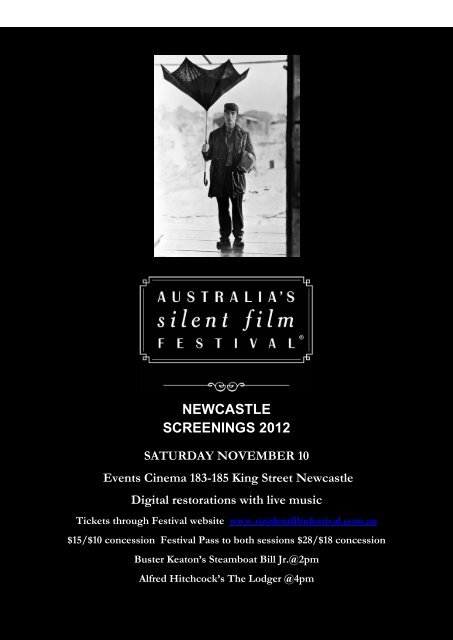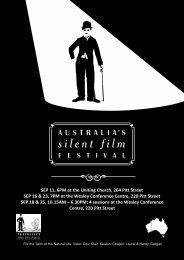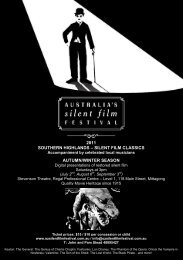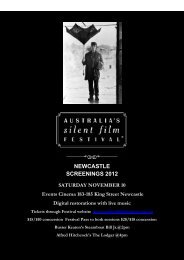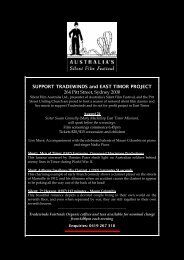NEWCASTLE SCREENINGS 2012 N - Australia's Silent Film Festival
NEWCASTLE SCREENINGS 2012 N - Australia's Silent Film Festival
NEWCASTLE SCREENINGS 2012 N - Australia's Silent Film Festival
Create successful ePaper yourself
Turn your PDF publications into a flip-book with our unique Google optimized e-Paper software.
<strong>NEWCASTLE</strong><br />
<strong>SCREENINGS</strong> <strong>2012</strong><br />
N<br />
SATURDAY NOVEMBER 10<br />
Events Cinema 183-185 King Street Newcastle<br />
Digital restorations with live music<br />
Tickets through <strong>Festival</strong> website www.ozsilentfilmfestival.com.au<br />
$15/$10 concession <strong>Festival</strong> Pass to both sessions $28/$18 concession<br />
Buster Keaton’s Steamboat Bill Jr.@2pm<br />
Alfred Hitchcock’s The Lodger @4pm<br />
1
Saturday, November 10<br />
2pm to 3.30pm<br />
Steamboat Bill, Jr (1928) 69 minutes One of Keaton’s greatest feature films with breathtaking<br />
stunts and action!<br />
Saturday, November 10<br />
4pm-5.45pm<br />
The Lodger (1927) 99 mins A quintessential Hitchcock psychological thriller.<br />
Musical accompaniment by Greg Smith on keyboards.<br />
PROGRAM NOTES BY BARBARA UNDERWOOD<br />
2
STEAMBOAT BILL JR. (1928)<br />
69 minutes USA<br />
Saturday November 10 @ 2 pm<br />
Director: Charles Reisner Starring: Buster Keaton<br />
No doubt the most recognised name and face of silent comedy next to Charlie Chaplin is Buster Keaton. One of the many reasons why<br />
Steamboat Bill Jr. is so highly acclaimed today is that it features one of the most famous and breathtaking stunts in film history. <strong>Film</strong>ed in<br />
Sacramento, California, with a production cost of $135,000, breakaway street sets and riverbanks were constructed and then their<br />
destruction by six powerful Liberty-motor wind machines was filmed for the famous hurricane scene.<br />
Keaton himself was suspended by a cable from a forty metre crane which turned him around, as if airborne in the wind storm.<br />
Buster who plays the sensitive college boy son, Bill Jr., reluctantly learns the river boating trade from his tough and grouchy father but is<br />
more interested in the daughter of his father’s riverboat rival, which leads to escalating antics, culminating in the amazing windstorm<br />
scenes.<br />
3
The Lodger - A story of the London Fog (1927) Great Britain 99 minutes<br />
Saturday November 10 @4pm<br />
Directed by Alfred Hitchcock, Novel written by Marie Belloc Lowndes.<br />
Cast : Ivor Novello, Marie Ault, Arthur Chesney, June Tripp, Malcolm Keen, Alfred Hitchcock and Alma Reville.<br />
The <strong>Festival</strong> acknowledges the generous assistance Park Circus Ltd.<br />
Highly acclaimed as Alfred Hitchcock’s best and most popular silent film, The Lodger is also an outstanding example of the visually<br />
artistic heights cinema had reached in the year 1927. In fact, the entire decade of the 1920s experienced rapid artistic and dramatic<br />
development, just as the previous two decades of motion pictures were revolutionary and ground-breaking.<br />
When editing, narrative and dialogue using title cards or intertitles had been mastered by the end of the 1910s, filmmakers began turning<br />
to the world of art and culture around them for new ideas and inspiration. Two of the most influential styles successfully expressed in<br />
early cinema were German Expressionism and Soviet Avant Garde.<br />
Alfred Hitchcock acknowledged that he was greatly inspired by German Expressionist directors F.W. Murnau and Fritz Lang when he<br />
worked at the famous old Babelsberg Studio in Berlin in the mid-1920s where he became well acquainted with the techniques and ideas<br />
behind Expressionism. In film, this art genre inspired the use of stark light and shadow to create mood and atmosphere, unusual camera<br />
angles and motion, and highly stylized and expressive acting, all in varying degrees.<br />
Hitchcock took the best of these techniques and blended them with his own style and ideas to create The Lodger, which is now regarded<br />
as his first true Hitchcockian film, although his lesser-known earlier film, Blackmail (1926), also clearly reveals all the famous hallmarks of<br />
the classic Hitchcock mystery thriller.<br />
The Lodger was adapted for the screen from the 1913 novel of the same name by Marie Belloc Lowndes, who based this ‘story of the<br />
London Fog’ on the Jack the Ripper murders. Such a subject is ideally suited to the Expressionist style, but Hitchcock uses these<br />
techniques sparingly and subtly, while adding other poignant qualities.<br />
5
An example of one such unforgettable scene is viewing the upstairs lodger pacing in his room through a transparent, glass ceiling while<br />
the candelabra shakes to the vibrations of his restless footsteps. These few seconds of visual cinematic genius conveys more than<br />
sounds or spoken words could express, and this is, in fact, the essence of the art of the silent film.<br />
Another stroke of genius, perhaps, was to cast the enigmatic and multi-talented Welsh actor, Ivor Novello in the lead role because his<br />
mere appearance as the Lodger is striking, while his long thin hands and unusual manner cause as much distress and unease in the<br />
viewer as among the family who is taking in this eerie stranger. It is their daughter, Daisy, however, who soon sees other qualities in<br />
him and creates a romantic triangle involving the detective who is trying to woo her.<br />
Tension and suspense escalate throughout the film as the viewer is continually tormented with the question of whether the lodger is the<br />
infamous serial killer of blonde women, or whether his suspicious behaviour has another explanation.<br />
Just as the real life murders of Jack the Ripper gripped an entire nation, so did The Lodger, and its success resulted an adaptation for<br />
the CBS radio series, Suspense, and four further remakes: the early sound version of The Lodger (1932), also starring Ivor Novello, a<br />
1944 version starring George Sanders and Merle Oberon, and in 1953 Jack Palance played the lodger in Man in the Attic.<br />
The newest remake of The Lodger was directed by David Ondaatje in 2009, this time set in West Hollywood but with references to Jack<br />
the Ripper and still firmly based on the original novel by Marie Lowndes.<br />
6
AUSTRALIA'S SILENT FILM FESTIVAL<br />
www.ozsilentfilmfestival.com.au<br />
Phone 0419267318<br />
info@ozsilentfilmfestival.com.au<br />
10
We acknowledge the invaluable and generous support from the renowned David Shepard, <strong>Film</strong> Preservation Associates and<br />
Blackhawk <strong>Film</strong>s, Jeff Masino and Flicker Alley, Lobster <strong>Film</strong>s and the sublime flair and talents of Stephanie Khoo, Shana<br />
Dennis and Frank Murri and the Newcastle <strong>Film</strong> Society.<br />
Please visit and read about your favourite silent film with the superb reviews at Amazon by the <strong>Festival</strong>’s tireless supporter,<br />
Barbara Underwood, whose notes grace these pages.<br />
www.ozsilentfilmfestival.com.au<br />
11


